#celastrus orbiculatus
Text
Six best sellers you must buy before 2022 ends
Six best sellers you must buy before 2022 ends
Best sellers are changing every week every month and every year but we picked some of the best books for you. Everyone loves to read books it can be fantasy novels, biographies, inspirational books, historical novels, or scientific exploration books. Books take you to another world that does not exist or books can explore an explore world that man can not enter, books can go in the time it can be…

View On WordPress
#a house of sky and breath#american bittersweet#anthony joshua sparring partners#autumn revolution bittersweet#be the match careers#bittersweet#bittersweet invasive#celastrus orbiculatus#factory night work near me#house of breath and sky#house of sky and breath#house of sky and breath release date#house of sky and breath target exclusive edition#indeed night work#match the picture#night work indeed#nightwork#oriental bittersweet#pacquiao sparring partners for spence#sparring partners#tesco night work#the match#the paris apartment#the paris apartment book#the paris apartment lucy foley#warehouse night work#where is the match
0 notes
Text
Walk With Me: 1/1/2023
Part of my personal superstition about the new year is that what I do on the first of January will have an impact on the entirety of the year ahead. With that in mind, my partner and I knew that we wanted to head out for a new year's walk. We both are deeply connected to the earth and ground best by being outside. Luckily, there is no shortage of places to get in a wonderful time in the woods nearby to where I live.
My partner had been wanting to take me to a semi-local old mineral mine that they found a while back while hiking with some friends. First, we approached from the cliffside which gave me a gorgeous view of the old stones of the mountainsides and my favorite of all of the evergreens, Eastern White Pine. I've written about Eastern White Pine a bunch in the past - it is a native to my area of the Northeast and I love to use it to make infused vodka. It's also quite good in all types of cooking - we've even added it to batches of fire cider in the past.

After scouting out the remains of the mine from above, we followed the trail around and down into the bowl below. This is a very old mine and it has been reclaimed by much of the vegetation that is native to this area (and some that aren't). I was particularly enamored with the beautiful Staghorn Sumac (Rhus typhina) that was growing tall and proud in the meadow space.
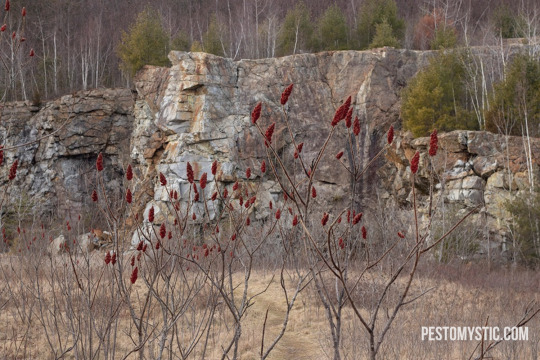
Here in the bowl left by the former excavations, we were mostly following deer trails through the foliage. The deer had munched on the closest staghorn, leaving behind long strange spirals at the tops of the plants. Staghorn sumac is edible and has many medicinal properties. As a spice, sumac is popular in a lot of Middle Eastern cuisines. I've been meaning to harvest some but want to be certain to find a place where the sumac will be free of toxins before trying it out.

Staghorn sumac wasn't the only edible plant that I found nearby. We also found some Cattails growing along the frozen pond. I've been told that Cattails are more of a survival food and that they are considered to be an acquired taste (at best) but I still would like to try some if I can source them safely.
On the less native side, many of the plants were covered in our local menace: Oriental Bittersweet (Celastrus orbiculatus). Bittersweet is extremely invasive in my area and every year it chokes out and brings down monstrous trees that have been alive for hundreds of years. It's sad to see Bittersweet so far out into the wilderness as we are here.

Sadly, it was not the only invasive that I found. Somehow, out in the middle of the woods on a game trail, we came across Rosa multiflora. This is a highly invasive Asiatic rose that is supposed to be all over my area but I rarely see it. I suspect that it is just less showy than Rosa rugosa. I almost didn't recognize it because its hips were so tiny!
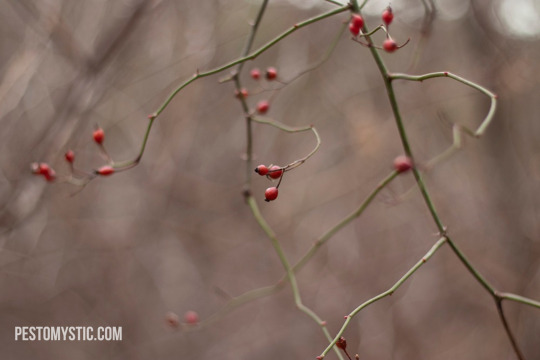
In any case, it was nice to see some color in the world. January is filled with many shades of gray and brown that are only sometimes broken up by the omnipresence of our many evergreens. Though I appreciate our pines, spruces, firs, and mountain laurels - it's nice to see a splash of red in amongst the forest. It is a reminder that even in winter, food can be found. And that soon enough, the ground will thaw and the cycle will be reborn anew.
#words#mine#photography#walk with me#woods#forest#New England#plant spirits#Eastern White Pine#Rosa multiflora#Oriental Bittersweet#Staghorn sumac#Cattails#January#Winter
14 notes
·
View notes
Text

bittersweet (Celastrus orbiculatus)
5 notes
·
View notes
Text
From the bottom of my heart, with every sincerity and true depth of feeling, I would like to express the sentiment
fuck Celastrus orbiculatus
#stg this stuff would eat the entire state of new york in five years if humans vanished#okay maybe ten#less than twenty though for like 90% coverage i bet
6 notes
·
View notes
Text
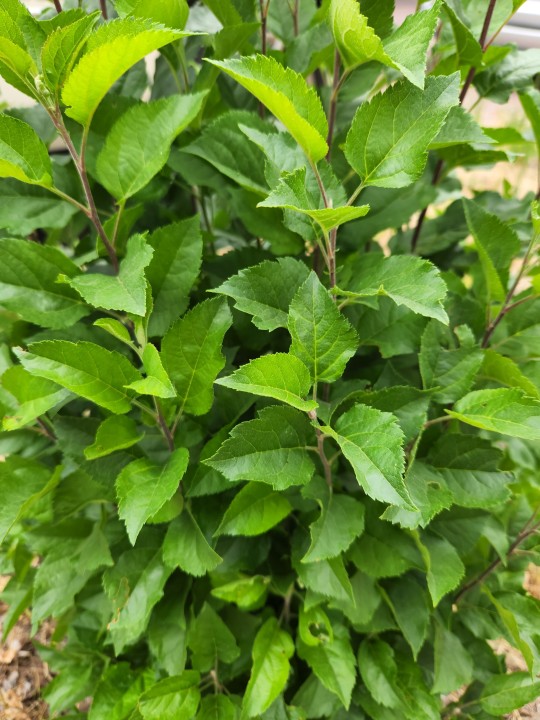
Celastraceae Celastrus orbiculatus
Oriental Bittersweet
Identification via Pl@ntNet
0 notes
Text
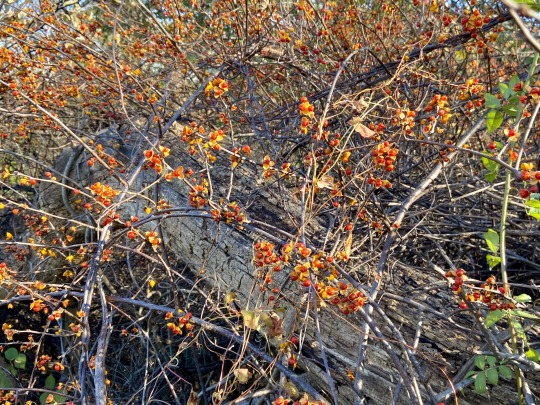
Asiatic bittersweet.
129 notes
·
View notes
Photo





Celastrus orbiculatus vines and damage.
Commonly known as oriental bittersweet, this is an invasive and highly damaging vining plant that is superseding the native species of bittersweet (Celastrus scandens) with aggressive growth and by interbreeding and producing sterile seeds. Photographed in SE Ohio.
5 notes
·
View notes
Text
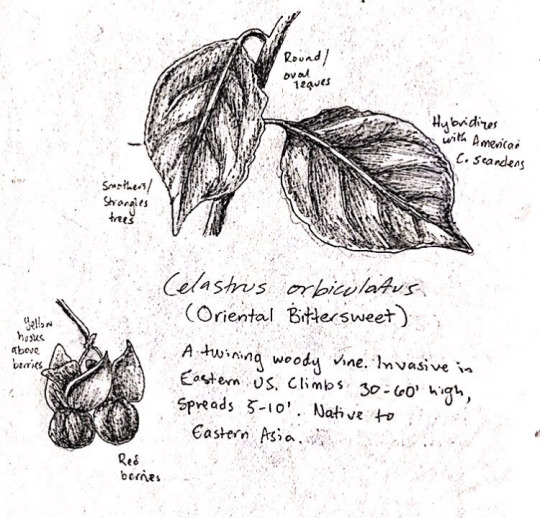
celastrus orbiculatus
#my art#botanical illustration#pen#black and white#horticulture#botany#scientific illustration#plants#flowers#gardening#field guide#celastrus orbiculatus#oriental bittersweet
38 notes
·
View notes
Photo

Bittersweet (Celastrus orbiculatus)
New Jersey, November 2, 2017.
Photo by @mellowcat-artist all rights reserved.
Rebloggers please do not delete caption, credits or links. NO reblogs to NSFW/18+ sites. Thanks.
#MellowCat#MellowCat-Artist#photographers on tumblr#nature photography#oriental bittersweet#Celastrus orbiculatus#macro photography#original photography#original photographers#autumn#fall#invasive species
116 notes
·
View notes
Text
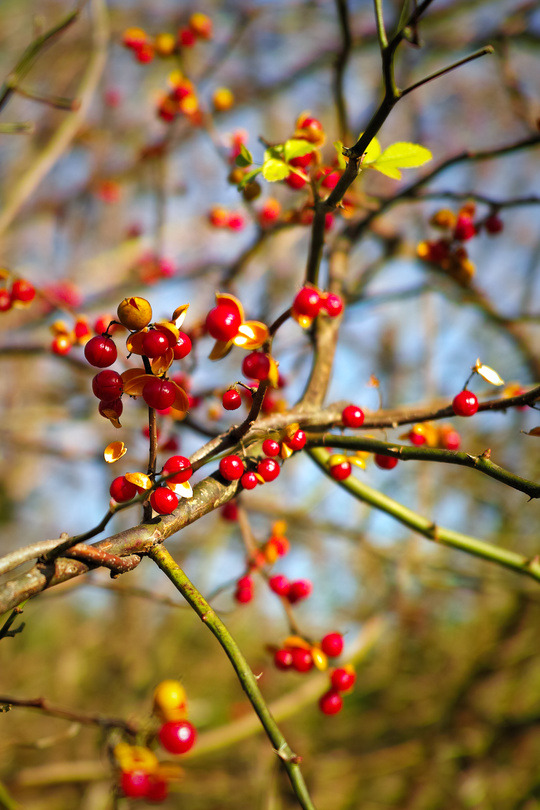
蔓梅擬[Tsuruumemodoki]
Celastrus orbiculatus var. orbiculatus
蔓[Tsuru] : Vine, creeping plant
梅擬[Umemodoki] : Ilex serrata
梅擬 is named for its leaves, which resemble those of 梅[Ume](Prunus mume). 擬[Modoki] means pseudo- or quasi-. There is a type of fried tofu patties called 雁擬[Ganmodoki], which made to resemble wild goose meat in its taste. Wild goose is called 雁[Gan]. 擬 is also read as gi.
https://en.wikipedia.org/wiki/Ganmodoki
The yellow capsules, the vermilion pseudo-seed coats and the appearance of the vines, they are tasteful, so this plant is often used for Ikebana, Bonsai and other artistic purposes.
https://bunka.nii.ac.jp/heritages/detail/429811
https://en.wikipedia.org/wiki/Sakai_Hōitsu
10 notes
·
View notes
Photo

Asiatic Bittersweet
The invasive Asiatic Bittersweet (Celastrus orbiculatus) is easy to spot in the woodlands now that the leaves have dropped. Brought to the United States in 1860 as an ornamental, the plants can damage trees through its overwhelming growth. It can be confused with the native bittersweet, which is not as destructive. Birds contribute to the spread of this invasive plant as they consume the berries and drop the seeds after digestion.
20 notes
·
View notes
Photo

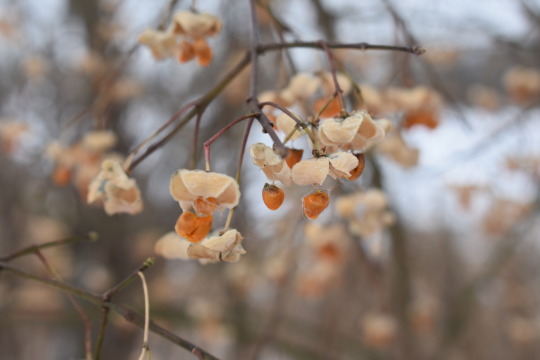
Oriental Bittersweet
Celastrus orbiculatus
Celastraceae Family
Photographs taken on January 19, 2020, at Centennial Park, Toronto, Ontario.
#wildflowers of southern ontario#bittersweet#Celastrus sp.#Celastrus genus#Celastrus#Celastraceae Family#Celastraceae#wildflowers#nature#plant#photography#winter#january#January 2020#centennial park#toronto#ontario#canada
46 notes
·
View notes
Photo
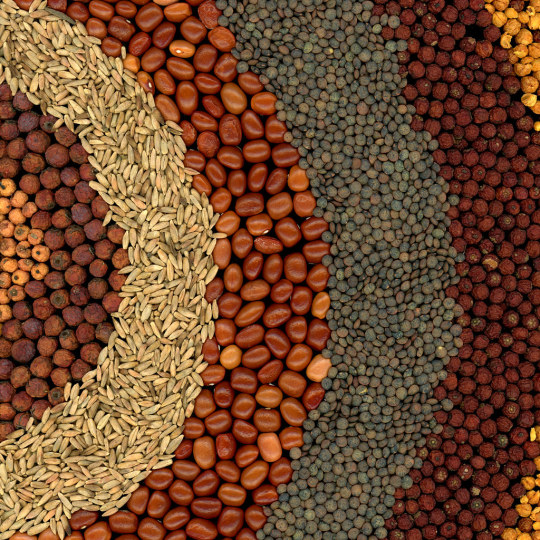
60156.20 Ilex verticillata, Crataegus, grass, Phaseolus, Lens culinaris, Celastrus orbiculatus by horticultural art https://flic.kr/p/2iq3agL
14 notes
·
View notes
Photo

60147.01 Phaseolus, Pisum sativum, Crataegus, Lens culinaris, Secale cereale, Ilex, Celastrus orbiculatus, Cucurbita by horticultural art https://flic.kr/p/2inkPBm
1 note
·
View note

